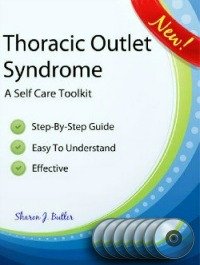Thoracic Outlet Syndrome Self Care Tips

Thoracic Outlet Syndrome self care? Posture should be your focus. If there was one repetitive strain injury that was most dependent on good posture, then Thoracic Outlet Syndrome would be it.
If you have Thoracic Outlet Syndrome it is essential that you correct any posture imbalances that you may have, whether in a sitting posture or in a standing posture. This will provide a more open pathway for the passage of the brachial plexus and should significantly reduce your symptoms.
It is almost impossible, however, to correct poor posture without also releasing adhesions that are affecting the muscles and interfering with their work.
Stretching Helps Restore The Brachial Plexus To Normal Function
Stretching exercises, practiced properly so that the limitations of injured tissues are respected, can also be extremely helpful in overcoming the symptoms of Thoracic outlet Syndrome.
Obviously, stretching all areas the brachial plexus passes through is very important. Stretching neck, chest, and shoulder muscles, including those that pass through the armpits, will help reduce the adhesions that are tugging on the brachial plexus.
Complete instructions on stretching within the limits of damaged tissue, along with the very best stretches to reach all the areas of the body affected by TOS are included in the Thoracic Outlet Self Care Toolkit. (See the link below.)
Choose The Right Pillow For Proper Support While Sleeping
Tips From Sharon
 |
For side sleepers, your arm can crush the brachial plexus at the front of the shoulder when you place it in front of your body as you sleep. To prevent this, take two polyester filled pillows and stuff them both into a single pillowcase. Place this large, round, overstuffed pillow in front of your body and drape your arm over it as you sleep. This keeps the area at the front of the shoulder open, preventing irritation to the brachial plexus. |
It is very important to make sure that the pillow you use under your head is the correct size and thickness for your body.
When you lie on your side, there will be some collapsing of the shoulders as your body weight sinks into the mattress. The pillow you choose should fill up the remaining space between the mattress and your head and should provide enough support to cradle the weight of your head without causing your neck to tilt in any direction.
Look for a pillow that will support the weight of your head and keep your spine in straight alignment.
Proper Hydration Is Critical

Click HERE to Learn More
Water intake is very important for Thoracic Outlet Syndrome because the condition is so dependent on the fluid state of the fascia of the upper body.
All the tissues that support and cradle the brachial plexus as it passes through the neck and upper chest and shoulders are dependent on proper hydration to adequately allow for normal sliding and gliding they are responsible for.
If these tissues become dry and irritated, then you can imagine how this can negatively impact and prolong the symptoms of Thoracic Outlet Syndrome.
Make sure you drink plenty of water each day!
Use A Headset For Your Telephone
Using a headset on your telephone can be a low cost solution for the strain that often develops as a result of holding the phone between the shoulder and neck. Visit your local telephone or office supply store to find low cost headphones that can easily attach to your home or office phones.
Move In New Ways To Keep Fascia Hydrated
Often the tissues of the upper body become sticky and restricted because as we age we tend to use our bodies in more and more predictable ways. This causes the tissues to become trained to move only in certain patterns, limiting the range of motion of the neck, shoulders and upper chest.
A really helpful way to overcome this tendency is to begin with gentle movements that are different from the customary ways you usually move your body. An example might be to slowly and rythmically rotate your torso back and forth, allowing your arms to swing loosely at your sides, much like you may have done as a child.
Yoga or gentle aerobics programs that include exercises that move your arms and upper body through a variety of ranges of motion can also be helpful. You can often find simple, gentle exercises of this nature in aerobics programs designed for senior citizens. Start with this level of intensity before moving on to programs that are designed for people who have bodies that can move more normally and without pain.
Break The Habit Of Unconsciously Raising Your Shoulders
Tips From Sharon
 |
One of the easiest and most effective ways I have found to break the habit of unconsciously raising your shoulders is with The Tape Trick. Practice this simple process for one week and see the difference it makes! |
Another common and destructive habit that many people with Thoracic Outlet Syndrome develop is to raise their shoulders unconsciously.
This pattern is often repeated hundreds of times throughout the day as a result of resting arms on armrests that are too high, resting the hands on the hips, carrying infants or small children, raising shoulders to hold a shoulder purse or computer bag on one shoulder, etc.
See how many of these patterns you can begin to recognize in your own life.
Thoracic Outlet Syndrome is one of the most challenging repetitive strain injuries. If you realize from the beginning that it will take a real concerted effort on your part to change posture habits, stretch the appropriate areas that are associated with symptoms, and correct the other personal habits that lead to compression of the brachial plexus, then you can certainly succeed in improving the symptoms of Thoracic Outlet Syndrome.
Don’t give up! You can make it happen!
Discover more about Thoracic Outlet Syndrome by checking out these additional sections:
How To Recover From Thoracic Outlet Syndrome
Thoracic Outlet Syndrome Symptoms
Thoracic Outlet Syndrome Anatomy
Click the block below that most closely matches your injury for more information and to find the Toolkit we offer to help you in your recovery.







